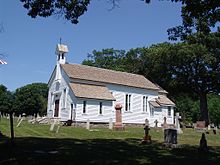St. James on-the-Lines
| St. James on-the-Lines | |
|---|---|
 |
|
| 44°47′13″N 79°55′34″W / 44.78694°N 79.92611°WCoordinates: 44°47′13″N 79°55′34″W / 44.78694°N 79.92611°W | |
| Location | Penetanguishene, Ontario |
| Country | Canada |
| Denomination | Anglican |
| Architecture | |
| Status | Parish church |
| Functional status | Active |
| Heritage designation | Ontario Heritage Trust |
| Designated | Jan. 20 1981 |
| Style | Greek Revival with Gothic Revival elements |
| Groundbreaking | 1836 |
| Completed | 1840 |
| Administration | |
| Parish | Penetanguishene |
| Episcopal area | York-Simcoe |
| Diocese | Anglican Diocese of Toronto |
St. James on-the-Lines (often written as St. James-on-the-Lines or St. James On-the-Lines) is a historic Anglican garrison church in Penetanguishene, Ontario. The church is still in use today serving as the Anglican parish church in Penetanguishene for services from Easter to Thanksgiving. The church is protected by a heritage conservation easement under the Ontario Heritage Act. There are two suggested origins for its full name. The first suggestion comes from its location on the lines of communication or road from the former military establishment at Penetanguishene to the south. The second possible meaning is from the old Victorian military usage of Lines for the rows of tents or buildings in a military camp. The church was constructed close to the original military establishment buildings which lined the road.
The church was constructed between 1836 and 1840. Colonel James Keating as commander of the Army establishment encouraged the building of the church for the use of the troops. He obtained a grant of land between the base and the town of Penetanguishene, The construction was financed with funds mostly raised by Captain John Moberly RN, the commander of the Penetanguishene Naval Yard. Keating and Moberley are both buried in the cemetery surrounding the church.
The first rector, Rev, George Hallen served as incumbent for 36 years and is buried in the cemetery adjoining the church. After the Military Establishment closed in 1856, it became a Reformatory for Boys with Hallen as the Chaplain. Worship continued in the church with the congregation consisting of townspeople, farming settlers and military pensioners who had been granted two acre plots in the area. It remained the only Protestant church in the area until the 1870s.
The church was protected as a historic site by the Ontario Heritage Trust in 1981 and the congregation raised funds from donations and government grants to restore and repair the deterioration of the building that had occurred. This restoration was completed by 1985. .
...
Wikipedia
